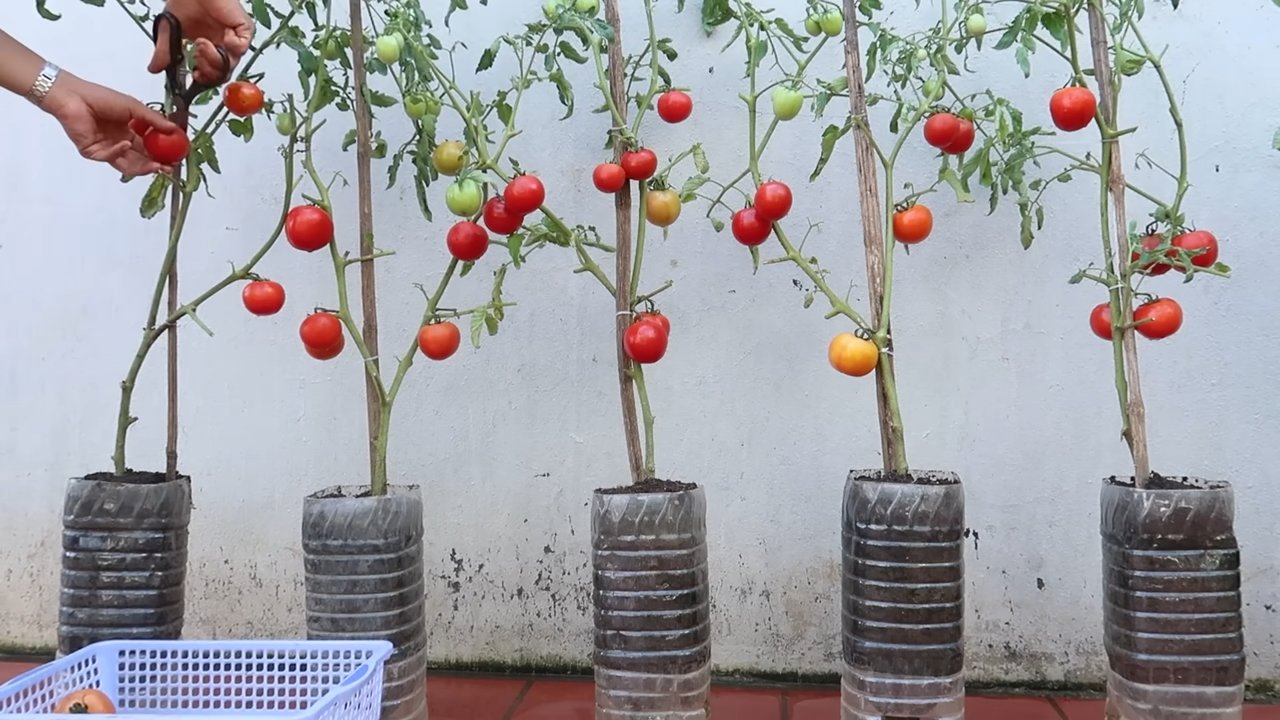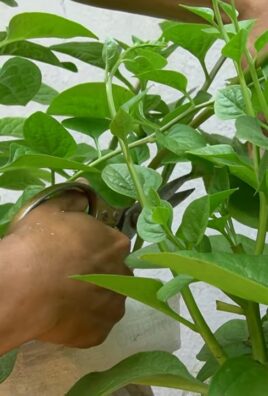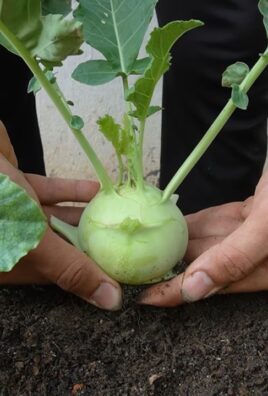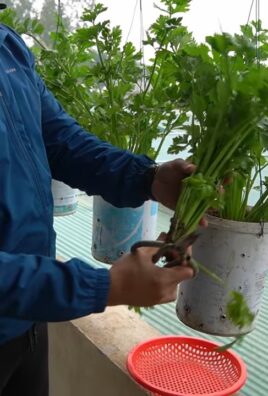Tomato garden for family: Imagine biting into a sun-warmed, juicy tomato, bursting with flavor, knowing you grew it yourself, right in your backyard! There’s something incredibly satisfying about nurturing a plant from seed to fruit, and sharing that bounty with your loved ones. For generations, families have cultivated tomato gardens, passing down knowledge and creating lasting memories. From the ancient Aztecs, who first domesticated the wild tomato, to Italian immigrants who popularized tomato sauce in America, this vibrant fruit has a rich cultural history deeply intertwined with family traditions and culinary delights.
But let’s be honest, starting a tomato garden for family can feel a little daunting. Where do you even begin? What if you don’t have a green thumb? That’s where this DIY guide comes in! I’m going to share some simple, yet effective, tricks and hacks that will help you create a thriving tomato patch, even if you’re a complete beginner. We’ll cover everything from choosing the right varieties for your climate to dealing with common pests and diseases. So, ditch the bland supermarket tomatoes and get ready to enjoy the taste of homegrown goodness. Let’s get our hands dirty and create a tomato garden your family will love!

Dein eigener Tomatengarten für die Familie: So geht’s!
Hey Leute! Ich zeige euch heute, wie ihr einen fantastischen Tomatengarten für eure Familie anlegen könnt. Es ist einfacher, als ihr denkt, und es gibt nichts Besseres als den Geschmack von sonnengereiften, selbst angebauten Tomaten! Lasst uns loslegen!
Was du brauchst: Die Materialliste
Bevor wir anfangen, stelle sicher, dass du alles hast, was du brauchst. Hier ist eine Liste:
* Tomatensamen oder Jungpflanzen: Wähle Sorten, die deiner Familie schmecken und für dein Klima geeignet sind. Ich empfehle eine Mischung aus verschiedenen Sorten für mehr Abwechslung.
* Anzuchterde: Für die Anzucht der Samen. Normale Gartenerde ist dafür nicht geeignet, da sie zu schwer ist.
* Anzuchttöpfe oder -schalen: Kleine Behälter für die Anzucht.
* Gartenerde: Hochwertige Gartenerde, am besten angereichert mit Kompost.
* Kompost: Ein Muss für gesunde Tomatenpflanzen!
* Tomatenstäbe oder -gitter: Zum Stützen der Pflanzen, wenn sie größer werden.
* Gießkanne oder Gartenschlauch: Zum Bewässern der Pflanzen.
* Gartenschere: Zum Ausgeizen der Tomatenpflanzen.
* Mulchmaterial: Stroh, Holzhackschnitzel oder Rasenschnitt, um den Boden feucht zu halten und Unkraut zu unterdrücken.
* Dünger: Spezieller Tomatendünger oder organischer Dünger.
* Pflanzschaufel oder Spaten: Zum Pflanzen der Tomaten.
* Handschuhe: Um deine Hände sauber zu halten.
* Etiketten und Stift: Um die verschiedenen Tomatensorten zu kennzeichnen.
* Optional: Ein kleines Gewächshaus oder Frühbeetkasten für die Anzucht.
Phase 1: Die Anzucht (ca. 6-8 Wochen vor dem letzten Frost)
Wenn du mit Samen beginnst, musst du die Tomaten vorziehen. Das gibt ihnen einen Vorsprung, bevor sie ins Freie kommen.
1. Samen aussäen: Fülle die Anzuchttöpfe mit Anzuchterde. Drücke die Erde leicht an und säe die Tomatensamen etwa 0,5 cm tief ein. Lege nicht zu viele Samen in einen Topf, sonst musst du sie später pikieren.
2. Bewässern: Gieße die Erde vorsichtig an, am besten mit einer Sprühflasche, damit die Samen nicht weggespült werden. Die Erde sollte feucht, aber nicht nass sein.
3. Warm stellen: Stelle die Anzuchttöpfe an einen warmen, hellen Ort. Eine Temperatur von 20-25°C ist ideal. Ein kleines Gewächshaus oder ein Frühbeetkasten sind perfekt, aber ein Fensterbrett über einer Heizung tut es auch.
4. Feucht halten: Halte die Erde feucht, indem du sie regelmäßig besprühst. Vermeide Staunässe.
5. Keimung abwarten: Die Samen keimen normalerweise innerhalb von 7-14 Tagen.
6. Pikieren: Sobald die Sämlinge ihre ersten richtigen Blätter (neben den Keimblättern) haben, kannst du sie pikieren. Das bedeutet, dass du jeden Sämling vorsichtig aus dem Anzuchttopf nimmst und in einen eigenen, größeren Topf mit Anzuchterde pflanzt. Achte darauf, die Wurzeln nicht zu beschädigen.
7. Weiter pflegen: Stelle die pikierten Sämlinge wieder an einen hellen, warmen Ort und halte die Erde feucht. Drehe die Töpfe regelmäßig, damit die Pflanzen nicht zum Licht wachsen und krumm werden.
Phase 2: Vorbereitung des Beetes
Während deine Tomatenpflanzen wachsen, kannst du das Beet vorbereiten. Tomaten lieben einen sonnigen Standort mit gut durchlässigem Boden.
1. Standort wählen: Wähle einen sonnigen Standort, der mindestens 6-8 Stunden Sonne pro Tag bekommt.
2. Boden vorbereiten: Grabe den Boden um und entferne Unkraut, Steine und Wurzeln. Lockere den Boden gut auf.
3. Kompost einarbeiten: Arbeite reichlich Kompost in den Boden ein. Kompost verbessert die Bodenstruktur, speichert Feuchtigkeit und liefert Nährstoffe.
4. Düngen: Wenn dein Boden sehr nährstoffarm ist, kannst du ihn zusätzlich mit einem organischen Dünger anreichern.
5. Beet anlegen: Du kannst ein normales Beet anlegen oder ein Hochbeet bauen. Hochbeete sind besonders praktisch, da sie den Boden erwärmen und die Pflanzen besser vor Schädlingen schützen.
Phase 3: Das Auspflanzen (nach dem letzten Frost)
Sobald keine Frostgefahr mehr besteht, können die Tomatenpflanzen ins Freie.
1. Abhärten: Bevor du die Pflanzen auspflanzt, solltest du sie abhärten. Das bedeutet, dass du sie für ein paar Tage stundenweise ins Freie stellst, damit sie sich an die Sonne und den Wind gewöhnen.
2. Pflanzlöcher graben: Grabe Pflanzlöcher, die etwas größer sind als die Wurzelballen der Tomatenpflanzen.
3. Pflanzen einsetzen: Nimm die Tomatenpflanzen vorsichtig aus den Töpfen und setze sie in die Pflanzlöcher. Achte darauf, dass die oberste Schicht des Wurzelballens mit der Erdoberfläche abschließt.
4. Anhäufeln: Häufele die Erde um die Stängel der Tomatenpflanzen an. Das fördert die Wurzelbildung.
5. Gießen: Gieße die Pflanzen gründlich an.
6. Stützen anbringen: Setze Tomatenstäbe oder -gitter neben die Pflanzen, damit sie später Halt haben.
7. Mulchen: Bedecke den Boden um die Pflanzen mit Mulchmaterial. Das hält den Boden feucht, unterdrückt Unkraut und schützt die Pflanzen vor Spritzwasser.
Phase 4: Pflege während der Saison
Tomaten brauchen regelmäßige Pflege, um gut zu wachsen und viele Früchte zu tragen.
1. Gießen: Gieße die Tomatenpflanzen regelmäßig, besonders bei trockenem Wetter. Gieße am besten morgens, damit die Blätter abtrocknen können und Pilzkrankheiten vermieden werden. Vermeide es, die Blätter zu gießen.
2. Düngen: Dünge die Tomatenpflanzen alle 2-3 Wochen mit einem speziellen Tomatendünger oder einem organischen Dünger.
3. Ausgeizen: Entferne regelmäßig die Seitentriebe (Geiztriebe), die in den Blattachseln wachsen. Das fördert die Bildung von Früchten und verhindert, dass die Pflanzen zu buschig werden.
4. Stützen: Binde die Tomatenpflanzen regelmäßig an die Stäbe oder Gitter, damit sie nicht umknicken.
5. Schädlinge und Krankheiten bekämpfen: Achte auf Schädlinge und Krankheiten und bekämpfe sie bei Bedarf mit geeigneten Mitteln. Es gibt viele biologische Mittel, die du verwenden kannst.
6. Ernten: Ernte die Tomaten, sobald sie reif sind. Sie sollten eine intensive Farbe haben und leicht nachgeben, wenn du sie leicht drückst.
Zusätzliche Tipps für eine reiche Ernte
* Sortenwahl: Wähle Tomatensorten, die für dein Klima und deine Bedürfnisse geeignet sind. Es gibt viele verschiedene Sorten, von kleinen Cherrytomaten bis hin zu großen Fleischtomaten.
* Fruchtfolge: Pflanze Tomaten nicht jedes Jahr am selben Standort. Wechsle die Pflanzen ab, um Krankheiten und Schädlingen vorzubeugen.
* Begleitpflanzen: Pflanze Begleitpflanzen wie Basilikum, Ringelblumen oder Kapuzinerkresse neben die Tomaten. Sie schützen die Pflanzen vor Schädlingen und fördern das Wachstum.
* Regelmäßiges Gießen: Achte darauf, dass die Tomatenpflanzen ausreichend Wasser bekommen, besonders während der Fruchtbildung.
* Sonnenschutz: In sehr heißen Regionen kann es sinnvoll sein, die Tomatenpflanzen vor der Mittagsson

Conclusion
So, there you have it! Transforming your outdoor space into a thriving tomato garden for your family is not only achievable, but incredibly rewarding. We’ve walked through the essential steps, from selecting the perfect tomato varieties to nurturing them with the right soil and sunlight. But more than just a practical guide, this is an invitation to connect with nature, teach your children about where their food comes from, and enjoy the unparalleled flavor of homegrown tomatoes.
Why is this DIY trick a must-try? Because it’s about more than just saving money at the grocery store. It’s about creating a sustainable food source, reducing your carbon footprint, and experiencing the joy of watching something grow from a tiny seed into a bountiful harvest. Imagine the satisfaction of serving your family a fresh tomato salad, knowing that every single tomato was nurtured by your own hands. That’s a feeling that money simply can’t buy.
Don’t be afraid to experiment with different tomato varieties to find your family’s favorites. Cherry tomatoes are perfect for snacking, while Roma tomatoes are ideal for making sauces. Heirloom varieties offer unique flavors and colors that you won’t find in store-bought tomatoes. Consider companion planting with basil, marigolds, or carrots to deter pests and improve the overall health of your tomato plants. You can also explore different growing methods, such as container gardening or vertical gardening, if you have limited space.
We encourage you to take the plunge and start your own tomato garden for your family this season. It’s an investment in your health, your happiness, and your connection to the natural world. And remember, gardening is a learning process. Don’t be discouraged if you encounter challenges along the way. Every mistake is an opportunity to learn and grow.
We’re confident that you’ll be amazed by the results. So, grab your gardening gloves, get your hands dirty, and start creating your own tomato paradise. And most importantly, don’t forget to share your experiences with us! We’d love to hear about your successes, your challenges, and your favorite tomato recipes. Share your photos and stories on social media using [Your Hashtag] and let’s inspire others to embrace the joy of homegrown tomatoes. Happy gardening!
Frequently Asked Questions (FAQ)
What are the best tomato varieties for beginners?
For beginners, we highly recommend starting with determinate tomato varieties like Roma, Celebrity, or Better Bush. These varieties are more compact and require less pruning than indeterminate varieties. They also tend to produce a large harvest all at once, making them ideal for canning or making sauces. Cherry tomatoes are also a great option for beginners, as they are relatively easy to grow and produce a continuous harvest throughout the season. Consider also the climate you live in and choose varieties that are known to thrive in your region. Local nurseries are a great resource for this information.
How much sunlight do tomato plants need?
Tomato plants need at least 6-8 hours of direct sunlight per day to thrive. Choose a location in your garden that receives full sun throughout the day. If you live in a particularly hot climate, you may want to provide some afternoon shade to prevent the plants from overheating. Insufficient sunlight can lead to leggy plants with poor fruit production.
What type of soil is best for tomato plants?
Tomato plants prefer well-drained soil that is rich in organic matter. Amend your soil with compost, aged manure, or other organic materials to improve its fertility and drainage. A slightly acidic soil pH of 6.0-6.8 is ideal for tomato plants. You can test your soil pH using a soil testing kit or by sending a sample to your local agricultural extension office.
How often should I water my tomato plants?
Water your tomato plants deeply and regularly, especially during hot, dry weather. Aim to water at the base of the plant to avoid wetting the foliage, which can increase the risk of fungal diseases. Check the soil moisture regularly by sticking your finger into the soil. If the top inch of soil is dry, it’s time to water. Avoid overwatering, as this can lead to root rot. A good rule of thumb is to water deeply once or twice a week, depending on the weather conditions.
How do I prevent pests and diseases in my tomato garden?
There are several things you can do to prevent pests and diseases in your tomato garden. First, choose disease-resistant tomato varieties. Second, practice good sanitation by removing any dead or diseased leaves from the plants. Third, use organic pest control methods, such as insecticidal soap or neem oil, to control common pests like aphids and tomato hornworms. Fourth, rotate your crops each year to prevent soilborne diseases from building up. Fifth, consider companion planting with basil, marigolds, or other plants that deter pests. Finally, ensure proper air circulation around your plants by spacing them adequately and pruning them regularly.
When should I start harvesting my tomatoes?
Tomatoes are typically ready to harvest when they are fully colored and slightly soft to the touch. Gently twist the tomato from the vine, leaving the stem attached. The exact time of harvest will depend on the variety of tomato and the weather conditions. Check your plants regularly and harvest the tomatoes as they ripen. Overripe tomatoes will become soft and mushy.
Can I grow tomatoes in containers?
Yes, you can definitely grow tomatoes in containers! Choose a large container (at least 15 gallons) with drainage holes. Use a high-quality potting mix and provide the plants with plenty of sunlight and water. Container-grown tomatoes may require more frequent fertilization than those grown in the ground. Determinate tomato varieties are generally better suited for container gardening than indeterminate varieties.
What are some common problems that tomato growers face?
Some common problems that tomato growers face include blossom end rot, tomato hornworms, aphids, and fungal diseases like early blight and septoria leaf spot. Blossom end rot is caused by a calcium deficiency and can be prevented by ensuring that the soil is properly amended with calcium and that the plants are watered regularly. Tomato hornworms are large green caterpillars that can quickly defoliate tomato plants. They can be handpicked or controlled with Bacillus thuringiensis (Bt). Aphids are small, sap-sucking insects that can weaken tomato plants. They can be controlled with insecticidal soap or neem oil. Fungal diseases can be prevented by choosing disease-resistant varieties, practicing good sanitation, and ensuring proper air circulation around the plants.
How can I encourage more fruit production on my tomato plants?
To encourage more fruit production on your tomato plants, make sure they are getting enough sunlight, water, and nutrients. Fertilize regularly with a balanced fertilizer or a tomato-specific fertilizer. Prune your tomato plants to remove suckers (the small shoots that grow between the main stem and the branches). This will help to improve air circulation and direct the plant’s energy towards fruit production. You can also try gently shaking the tomato plants to help with pollination.
What can I do with excess tomatoes?
If you have a bumper crop of tomatoes, there are many things you can do with them! You can make tomato sauce, salsa, ketchup, or tomato soup. You can also can or freeze tomatoes for later use. Another option is to share your excess tomatoes with friends, family, or neighbors. You can also donate them to a local food bank or soup kitchen.




Leave a Comment